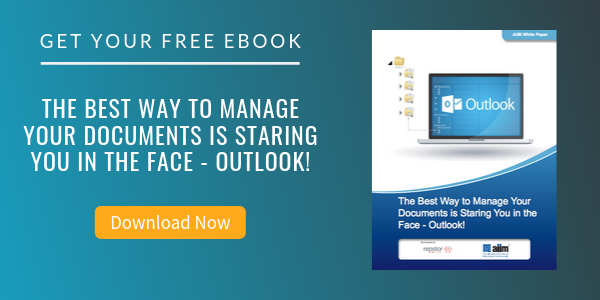
The Problem with Email Collaboration (and a Better Alternative)
Email Management | Collaboration
While social media, the cloud, and advanced enterprise content management systems get the most attention, the fact is that plain old email remains to be a foundational tool in the way business gets done.
And email shows no signs of going away any time soon. In fact, the total number of active email users jumped to 3.9 billion in 2019. American workers will receive an average of 126 emails a day. Like it or not, email remains the glue that ties an organization together. We use it to communicate with our bosses, colleagues, partners, and customers. We use it for storing important messages, and a lot of important collaboration happens in email. But, just because a tool can be used for a particular job doesn't mean it's the best option.
Three Common Business Problems with Email
Although it's not likely email will be going away anytime soon, there are some common challenges that businesses encounter with email when it comes to email management.
- Problems with the Volume of Email: First, the volume of email is often the biggest challenge for organizations to manage. This, coupled with the challenge to separate spam, personal communication, and routine notifications from content with long‐term business value, makes this a difficult problem for many organizations.
- The Risk Of Unmanaged Email: Next, unmanaged email represents a significant risk to any organization. Litigators, for example, often regard email as a “smoking gun” that will win their case or force a settlement.
- Email "Phishing" and Hacking: Finally, email can often present an entry point to hackers and cyber-thieves, who commonly use email “phishing’ techniques to gain entry to even the most sophisticated networks.
These challenges are just par for the course - or, just an assumed challenge when using email as a business communication tool. Businesses can overcome these challenges with a solid understanding of email management best practices.
The Biggest Limitation of Email
Next, we'll look at the biggest limitation of email - collaboration. Email is often used as a collaboration tool, but falls short in a number of ways. Lets take a look at where email comes up short for collaboration:
- Email Turns Collaboration Into Information Chaos: Email is a really good communication and notification tool, but we quickly end up with chaos when multiple people try to use email to discuss a topic or for developing something. We get reply one vs. all and reply to the first message vs. later messages. Email also creates knowledge silos where important information and knowledge get locked down or lost in personal and corporate email boxes.
- Email Locks Down Information and Knowledge: Gallup has found a correlation between the level of employee engagement and customer service by 10%, productivity by 21%, and profitability by 22%. Email hinders this since information and knowledge are locked down in personal and corporate email boxes. We need to replace these silos with open and flat networks.
- Email Distracts Knowledge Workers: New incoming emails have a tendency to distract us. We end up in a responsive mode instead of spending our time being strategic and creative. We used to have a “You got mail” audio alert in the old days; it’s now best to turn off all email notifications to be productive. We should only respond to email at certain times of the day, and some organizations have also implemented email free days. For me, the best place to be creative is the treadmill since I am then 100% disconnected!
- Email Lacks Information Filters: Often organizations don’t have an information overload problem; they have filter failure. Most of us have only spam filters for our emails – we don’t know if the rest of the emails are important or not until we look at them. Google has tried to fix this by adding a filter for important emails, but this feels quite basic.
- Email Makes it Difficult to Share Large Files: One of the reasons enterprise file sharing solutions like Box and Dropbox have become so popular is that organizations still have a need to share large files both inside and outside the firewall. In many organizations, attachment sizes are arbitrarily limited to, say, 5 MB. This means that the tool is getting in the way of doing the business of the organization, and whenever that happens, users WILL figure out a way to work around it.
A Better Way to Collaborate
Email is the de facto standard for business communication across organizations. For information workers, the email is their primary business application spending many hours a day reading, responding, and collaborating via emails.
However, empowering your employees with alternative tools for collaboration can drive new innovation and lead to greater production and engagement.
Implementing collaboration software gives your team a better way to interact through instant messaging, notifications, and status updates. Here are a few common ones to check out and research to determine which best suits your needs:
- For Real-Time Communication: Slack or Microsoft Teams
- For Full-Scale Collaborative Project Management: Airtable or Basecamp
- For Document Collaboration: Google Docs or Confluence
About Kevin Craine
Kevin Craine is a professional writer, an internationally respected technology analyst, and an award-winning podcast producer. He was named the #1 Enterprise Content Management Influencer to follow on Twitter and has listeners and readers worldwide. Kevin creates strategic content for the web, marketing, social media, and more. He is the written voice for some of North America's leading brands and his interviews feature today's best thought leaders. His client list includes many well-known global leaders like IBM, Microsoft and Intel, along with a long list of individuals and start-ups from a wide variety of industries. Kevin's podcasts have been heard around the world, including the award-winning weekly business show "Everyday MBA". He is also the host and producer of "Bizcast" on C-Suite Radio and the producer behind podcasts for Epson, Canon, IBM and AIIM International, among others. Prior to starting Craine Communications Group, Kevin was Director of Document Services for Regence BlueCross BlueShield where he managed high volume document processing operations in Seattle, Portland and Salt Lake City. He also spent time at IKON as an Enterprise Content Management consultant working with national and major accounts. He was the founding editor of Document Strategy magazine. Kevin has also been, at one point or another, an adjunct university professor, a black belt martial artist, and a professional guitarist. Kevin holds an MBA in the Management of Science and Technology as well as a BA in Communications and Marketing.



